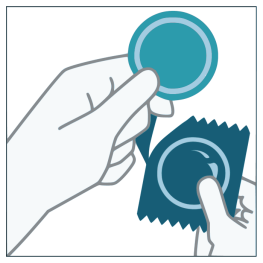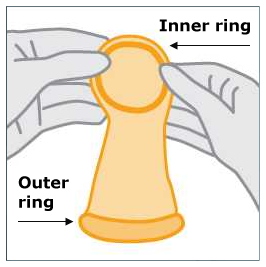Condoms and lubricants
Condoms and other barriers, when used regularly and correctly, greatly reduce the risk of getting HIV and other sexually transmitted infections (STIs).
- "Regular use" means using a condom or other barrier as often as possible for oral, vaginal, or anal sex.
- "Correct use" means following these steps. Note: Most condom failures result from incorrect use of the condom, not because the condom was faulty.
- Condoms are made of latex (rubber), polyurethane (plastic), or polyisoprene (plastic), and include both external (traditional) and internal (FC2®) condoms.
Tips for using external (traditional) condoms
 Latex or polyurethane and polyisoprene condoms are the best to use. People with latex allergies can use polyurethane or polyisoprene condoms as a latex alternative.
Latex or polyurethane and polyisoprene condoms are the best to use. People with latex allergies can use polyurethane or polyisoprene condoms as a latex alternative.- Condoms need to fit properly. They come in different sizes, shapes, and styles, so there is a condom for every penis size and shape.
- Condoms should be handled carefully before, during, and after opening. Condoms in damaged packages or past their expiration date should not be used. Condoms should not be stored for prolonged periods in a wallet or in hot or sunny places (for example, in a car or by a window).
- Condoms must be put on after an erection and before any oral, vaginal, or anal sex. Some condoms have a reservoir tip; some don't. In either case, the tip of the condom should be squeezed while the condom is unrolled in order to leave an airless pocket to collect semen.
- After intercourse, the penis should be withdrawn while still erect. During withdrawal, the base of the condom should be held around the base of the penis to prevent it from slipping off or spilling semen.
- Condoms should not be reused. Condoms should be thrown in the trash, not in the toilet (they can clog the toilet).
Tips for using internal (FC2) condoms
 The internal condom is an alternative to the traditional external condom for vaginal or anal sex.
The internal condom is an alternative to the traditional external condom for vaginal or anal sex.
- Like external condoms, internal condoms should be handled carefully before, during, and after opening. Condoms in damaged packages or past their expiration date should not be used. Condoms should not be stored for prolonged periods in a wallet or in hot or sunny places (for example, in a car or by a window).
- The internal condom must be inserted in the vagina or anus before any vaginal or anal sex to reduce HIV and STI transmission. It may be inserted up to 8 hours in advance of intercourse.
- The open end of the internal condom (at the outer ring) is designed to cover the area around the opening of the vagina or anus. The condom clings to the vaginal or rectal wall, providing a barrier between the vaginal lining and the penis.
- For insertion in the vagina, the inner ring should be squeezed between thumb and middle finger. The inner ring is used to guide insertion and to help hold the condom in place. The inner ring should be placed as far as it will go inside the vagina. It is in the right place when it can't be felt.
- Proper insertion into the vagina may require practice and can be improved by the cooperation of both partners.
- For insertion into the anus, remove the inner ring. The condom can be inserted in the rectum with fingers or placed on the erect penis. Proper insertion into the anus may require practice and can be improved by the cooperation of both partners.
- The condom should not be twisted. The outer ring should remain outside the vagina or anus.
- For removal, the outer ring should be grasped and twisted in the hand and then pulled gently to remove the entire condom.
- Internal condoms should not be reused. After use, internal condoms should be thrown in the trash, not in the toilet (they can clog the toilet).
Oral barriers
- Oral barriers must be placed on the genitals or anus before oral contact to prevent any exchange of fluids or any contact between mouth and the genitals or anus. The barrier should cover the vaginal opening and labia or the anus and perineum.
The barrier can be:
- A condom that has been cut to lay flat
- A dental dam
- A latex square
- Non-perforated plastic wrap
- A condom that has been cut to lay flat
- As with condoms, oral barriers need to be handled carefully. They shouldn't be stored for prolonged intervals in hot or sunny places (for example, in a wallet, in a car or by a window).
- Lubricant can be placed between the oral barrier and the genitals or anus.
- Barriers should not be reused. They should be thrown in the trash, not in the toilet (they can clog the toilet).

 Translate
Translate